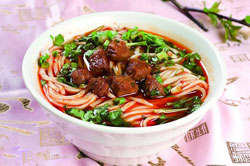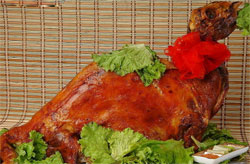Halal Food in China
 In Chinese, halal is called Qingzhen Cai (清真菜). Hahal food is easy to find in most major cities in China given the large Muslim population in China. Small Muslim restaurants and food stalls are also widely available in cities or towns because of the number of Muslim migrants from western China. Muslim restaurants in China are usually run by Muslim migrants, and offer cheap halal food given the greater prevalence of these meats in the cuisine of western Chinese regions.
In Chinese, halal is called Qingzhen Cai (清真菜). Hahal food is easy to find in most major cities in China given the large Muslim population in China. Small Muslim restaurants and food stalls are also widely available in cities or towns because of the number of Muslim migrants from western China. Muslim restaurants in China are usually run by Muslim migrants, and offer cheap halal food given the greater prevalence of these meats in the cuisine of western Chinese regions. Chinese halal food appeared over 1,000 years ago during the Tang Dynasty when Islam was introduced to China. Arabic businessmen, travelers and missionaries traveled to China along the ancient Silk Road, and settled in places like Xian, Kaifeng, Guangzhou, Quanzhou, Yangzhou and Hangzhou. These Arabic people were the ancestors of today’s Hui people in China. Chinese hahal food developed, and more dishes were created during the Yuan Dynasty when the Hui ethnic minority was formed.
Chinese halal food blendes the original Middle East flavors with traditional Chinese dishes, creating its own style. Wheat food and products are eaten more frequently than rice, and various dishes and snacks are made from wheat flour. Sweet flavors take an important role, probably related to Arabian Muslims' preference for a sweet taste. Beef and mutton are also widely eaten.
Famous Halal Dishes
Roasted Whole Lamb(烤全羊) Roasted Whole Lamb is the most famous dish in Xinjiang Province, and it can be found in major cities across China. The dish is prepared with selected ingredients and is cooked using a special cooking technique. When preparing, a mixture of flour and water with yelk, salt, ginger, and pepper powder is applied to shroud the entire carcass. The lamb is then put into a specially made oven and baked for around one hour. It is trimmed with red silk around its neck and served with it mouth stuffed with fresh caraway. When eating, people use a knife to cut the mutton from the lamb.
Roasted Whole Lamb is the most famous dish in Xinjiang Province, and it can be found in major cities across China. The dish is prepared with selected ingredients and is cooked using a special cooking technique. When preparing, a mixture of flour and water with yelk, salt, ginger, and pepper powder is applied to shroud the entire carcass. The lamb is then put into a specially made oven and baked for around one hour. It is trimmed with red silk around its neck and served with it mouth stuffed with fresh caraway. When eating, people use a knife to cut the mutton from the lamb. Lanzhou Hand pulled Noodles with Beef 兰州牛肉拉面
This kind of hand-pulled noodle is also known as the "Lanzhou Beef Noodles," one of the most common dishes in the local area. Visitors can see this dish being served on every corner of the city, and it has become a part of the local people's life. The noodle is handmade, and it takes a cook only one or two minutes to stretch the flour cake into many needle-like noodles. Today, small restaurants serving Lanzhou Beef Noodles can be found in almost every Chinese city. Most of them are hidden in small alleys or back streets.Among the many beef restaurants in Lanzhou, the Jinding Beef Noodle Restaurant on Pingliang Road, the Mazhilu Beef Noodle Restaurant on Wudu Road and the Minority Restaurant in Zhangye Road are the most famous.
Hand-taken Lamb 手抓羊肉
Hand-taken Lamb has a history of around one thousand years. It is so named because the lamb is eaten with one’s hand.
The lamb is boiled in soup, with ingredients such as pepper, onion and ginger. It is done when the meat is soft. The lamb can be served hot, cold or fried.
0 comments:
Post a Comment